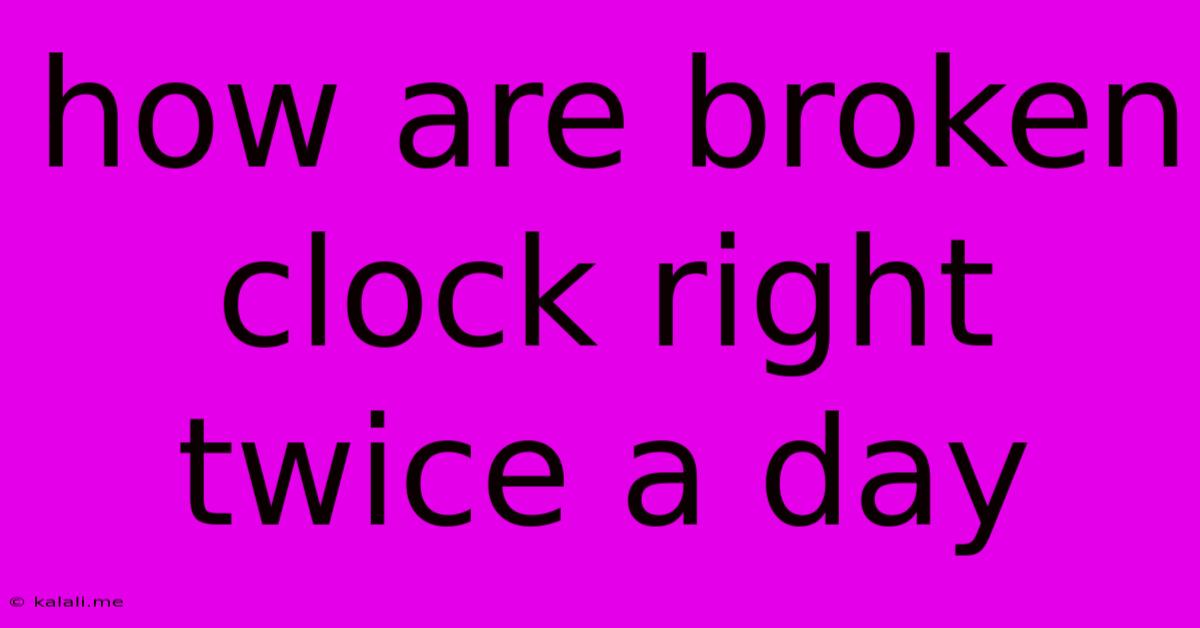How Are Broken Clock Right Twice A Day
Kalali
May 20, 2025 · 3 min read

Table of Contents
How a Broken Clock Is Right Twice a Day: An Exploration of Probability and Time
A common saying suggests that even a broken clock is right twice a day. But is this just a quirky expression, or is there actual mathematical truth behind it? This article explores the fascinating probability behind this statement, examining the conditions under which it holds true and the nuances of its interpretation. We'll delve into the mechanics of a non-functioning timepiece and its surprising accuracy, from a purely statistical perspective.
Understanding the Saying's Limitations
Before diving into the math, it's crucial to understand the context of the adage. The saying isn't about a clock that is mostly accurate, but rather a clock that is completely malfunctioning and displays a random time. It’s a clock that doesn't work at all, its hands frozen at some arbitrary point.
The statement relies on the assumption that the clock's hands are fixed in a position that randomly indicates a time. There is an underlying probability at play here. Let's break it down:
The Mathematics of Random Time
Imagine a 12-hour clock. The clock's hour hand can point to any point on the clock face, representing any time within a 12-hour cycle. To be "right," the clock needs to display the correct time twice during a 24-hour period.
Consider the following:
-
The Clock's Fixed Time: Our broken clock displays a single fixed time.
-
Correct Twice a Day: The probability of this fixed time randomly coinciding with the actual time twice in a 24-hour period is dependent on the random nature of the fixed time.
-
The 24-Hour Cycle: The earth rotates, meaning the actual time progresses continuously through a 24-hour cycle.
The "twice a day" aspect comes from the fact that the Earth rotates once every 24 hours. Given enough time, a fixed time on the broken clock will inevitably align with the actual time twice within this 24-hour period, once in the AM and once in the PM cycle.
Clarifying the Ambiguity:
It's important to note that the statement operates under certain assumptions:
- Consistent Error: The clock must remain consistently "broken" – its hands must not move.
- 12-Hour or 24-Hour Clock: The statement is generally applied to a 12-hour clock. On a 24-hour clock, it might be "right" only once a day.
- Perfect Synchronization: This is a simplified model, ignoring factors like leap seconds and variations in the Earth’s rotation speed.
Beyond the Simple Clock:
The concept extends beyond a literal clock. It serves as a metaphor for the unpredictable nature of coincidences and the inherent probabilistic nature of many seemingly random events in life. Sometimes, even seemingly flawed systems or processes might occasionally align with desired outcomes, purely by chance.
Conclusion:
While seemingly simplistic, the adage "a broken clock is right twice a day" reveals a compelling insight into probability and the surprising accuracy of random chance. Though the statement operates under specific, idealized conditions, it's a memorable reminder of the role of pure probability in our understanding of time and coincidences. The likelihood of alignment isn't a matter of skill or design, but rather a consequence of the interplay between a fixed, random variable (the broken clock's time) and a continuously changing variable (the actual time).
Latest Posts
Latest Posts
-
How To Fill A Pond In
May 21, 2025
-
Cf Card To Sd Card Adapter
May 21, 2025
-
Will Allah Forgive Me For Marrying A Non Muslim
May 21, 2025
-
What Is My Grandads Brother To Me
May 21, 2025
-
Will A Diesel Car Run On Petrol
May 21, 2025
Related Post
Thank you for visiting our website which covers about How Are Broken Clock Right Twice A Day . We hope the information provided has been useful to you. Feel free to contact us if you have any questions or need further assistance. See you next time and don't miss to bookmark.